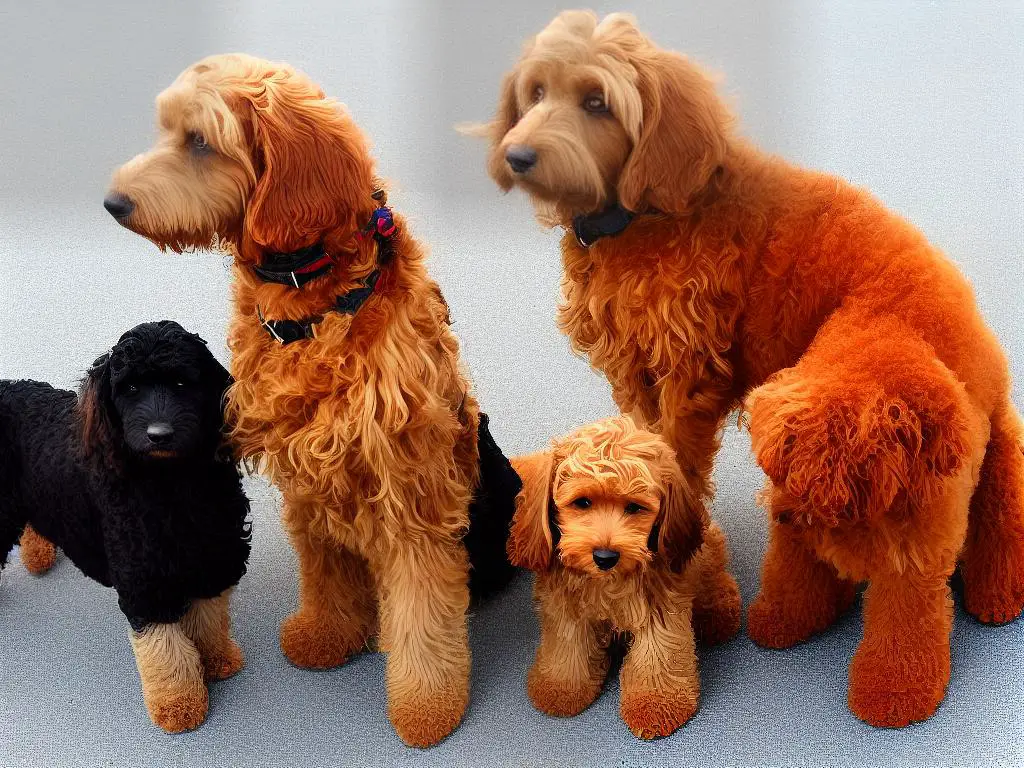Cockapoo vs Labradoodle:Choosing the Perfect Dog Breed
When it comes to choosing the perfect canine companion, it is essential to explore the various breeds and evaluate their characteristics to ensure the best match for your lifestyle and preferences. In recent years, crossbreed dogs such as Cockapoos and Labradoodles have gained popularity among dog enthusiasts, due to their lovable temperament, unique appearance, and hypoallergenic coats. This comprehensive guide delves into the world of Cockapoos and Labradoodles to provide an in-depth understanding of their origin, appearance, temperament, and care requirements, ensuring that you can make an informed decision when considering these charming breeds.
Origin & History
The tale of the Cockapoo and the Labradoodle begins with their respective parent breeds. The Cockapoo is a cross between the American Cocker Spaniel, which originated in the 1800s in the United States, and the Poodle, which hails from Germany and France. Similarly, the Labradoodle is a mix of the Labrador Retriever, developed in Newfoundland in the 1800s, and the Poodle.The first intentional breeding of Cockapoos is said to date back to the 1950s in the United States, making it one of the first so-called “designer breeds” to become popular.The primary reason for breeding a Cocker Spaniel with a Poodle was to develop a low-shedding and allergy-friendly family pet with a loving temperament and appealing appearance.Interestingly, the Cockapoo does not have a unified breed standard, as its breeding enthusiasts aim to maintain genetic diversity to reduce health issues common in purebred lines.The Labradoodle’s origin story is vastly different, as their initial purpose was not solely for companionship.The breed was created in Australia during the late 1980s when Wally Conron, who was working for the Royal Guide Dogs Association of Australia, received a request for a hypoallergenic guide dog from a visually impaired woman whose husband had allergies.He subsequently bred a Labrador Retriever, known for its excellent guiding ability, with a Poodle, known for its hypoallergenic coat, to develop the first Labradoodle.The breed quickly gained popularity as people became intrigued by the idea of a low-shedding, intelligent, and trainable guide dog.While both the Cockapoo and Labradoodle were initially bred with hypoallergenic coats and good temperaments in mind, their overall appearance and size can vary significantly due to the wide range of Poodle sizes.Cockapoos can inherit the size genes from Toy, Miniature, or Standard Poodles, resulting in adults weighing anywhere between 6 to 30 pounds.The Labradoodle, on the other hand, usually results from a cross between a Standard Poodle and a Labrador Retriever, yielding much larger dogs that can weigh between 50 to 80 pounds.In comparing the two breeds, it is essential to consider the parent breeds’ characteristics and desired outcomes of the initial crossbreeding efforts.While both Cockapoos and Labradoodles are known for their friendly and affectionate dispositions, the latter was specifically bred for exceptional intelligence and trainability as a service animal.However, both hybrids can make excellent family pets, as they are known for their adaptability, low-shedding coats, and loving temperaments.When considering getting a hybrid dog, enthusiasts or hobbyists must carefully weigh factors such as size, energy level, and specific breed traits to determine which would be the best fit for their needs. By doing so, they can make an informed decision between adopting a Cockapoo or Labradoodle.

Appearance & Size
Comparing the physical features of Cockapoos and Labradoodles, the most significant difference lies in their size. Cockapoos are a mix between a Cocker Spaniel and a Poodle, which results in a smaller, more compact dog. Typically, they stand between 10-15 inches tall at the shoulder and weigh anywhere from 12-24 pounds. Conversely, Labradoodles are a cross between a Labrador Retriever and a Poodle, making them a larger breed. They generally stand between 21-24 inches tall and weigh between 50-65 pounds. Owing to their Labrador heritage, Labradoodles can sometimes reach up to 100 pounds, making them a substantially larger breed compared to Cockapoos.
When it comes to coat types, both Cockapoos and Labradoodles inherit the Poodle’s low-shedding, hypoallergenic characteristic. However, there is a wide range of variation in the texture and thickness of their coats. Cockapoos may have a coat that is straight, wavy, or tightly curled, depending on which parent’s genes are more dominant. Labradoodles, too, can have a wide variety of coat types, which include fleece, wool, or hair. Fleece coats are soft and wavy, while wool coats are more tightly curled, and hair coats are straight and coarse. Both breeds require regular grooming to ensure their coat remains healthy and tangle-free.
Color is another element that varies within these two breeds. Cockapoos come in various shades, including black, white, cream, red, brown, or a mix of these colors. They also often display parti-color patterns, which are large patches of two or more colors on their coat. Labradoodles exhibit a more extensive variety of colors due to their Labrador lineage, including chocolate, cream, apricot, black, silver, and red. Additionally, Labradoodles may have various markings, such as white on their chest, face, or paws.
In terms of overall appearance, Cockapoos have a cute, cuddly look with a sturdy, well-balanced body, well-proportioned head, and medium-length muzzle. Their expressive eyes and full, floppy ears contribute to their endearing appeal. Labradoodles, on the other hand, are taller and more athletic in appearance, given their Labrador genetics. They have a strong, muscular build, a broad skull, and a well-defined stop. Despite their size difference, both breeds have similar facial expressions, often appearing alert and intelligent, with a hint of mischief.
Health-wise, both Cockapoos and Labradoodles are generally healthy breeds, but they can be prone to specific genetic issues. Cockapoos, with their smaller size and Cocker Spaniel heritage, may be more susceptible to eye issues, ear infections, and hip dysplasia. On the other hand, Labradoodles, owing to their larger stature and Labrador lineage, may also be prone to hip dysplasia, as well as conditions like progressive retinal atrophy and elbow dysplasia. It’s essential for owners of these breeds to be aware of potential health concerns and keep up with regular veterinary check-ups to ensure their pets maintain a happy and healthy life.

Temperament & Behavior
Aside from their health, these two breeds also have unique temperaments that make them perfect family pets. Both the Cockapoo and Labradoodle display friendly and affectionate personalities due to their Poodle heritage, resulting in high levels of intelligence that contribute to their trainability and adaptability in various situations.
The Cockapoo, a mix between a Cocker Spaniel and a Poodle, often has a more cuddly and gentle nature, making them perfect companions for people of all ages. In contrast, the Labradoodle, a cross between a Labrador Retriever and Poodle, inherits the Labrador’s outgoing and energetic personality, making them well-suited for active families or those interested in a sporting buddy.
When it comes to activity levels, the Labradoodle exhibits a higher energy level in comparison to the Cockapoo. Known for their agility and enthusiasm, Labradoodles require consistent exercise and mental stimulation to keep them content and well-adjusted. Although Cockapoos are energetic and playful, their exercise needs can be met with a daily walk and some playtime, making them a more adaptable breed for various living situations, such as urban apartments or suburban homes.
Both the Cockapoo and Labradoodle breeds are known for their social and affable dispositions, making them excellent choices for families with young children, other pets, or frequent visitors. These breeds thrive on interaction and form strong attachments to their family members. Due to their friendly nature and desire for companionship, they do not fare well when left alone for long periods, and some individuals may develop separation anxiety or related behavioral issues if not given adequate attention and socialization.
Both the Cockapoo and Labradoodle are highly intelligent and eager to please, rendering them highly trainable and well suited for various activities, such as therapy work, agility, or obedience. Early training and socialization are crucial for these breeds to utilize their intelligence positively and develop good manners. While they are adaptable to different lifestyles, they respond best to positive reinforcement methods and consistent guidance.
One notable difference between the Cockapoo and Labradoodle is their size and weight. Cockapoos tend to be smaller, typically ranging in size from 10 to 25 pounds, while Labradoodles can weigh anywhere from 30 to 65 pounds or more. This size difference can influence their suitability for specific households, with the smaller Cockapoo being better suited for apartment living or smaller homes, while the larger Labradoodle may require more space to roam and stretch its legs. Both breeds, however, adapt well to family environments and active lifestyles, thanks to their temperament and intelligence, making them popular choices for loving and loyal companions.

Training & Socialization
When considering training and socialization, it’s worth noting that both Cockapoos and Labradoodles are known for their intelligent, eager-to-please nature, which makes them relatively easy to train. As friendly, sociable, and adaptable breeds, they thrive in various environments. Their Poodle heritage, renowned for intelligence, helps ensure that learning comes naturally for these dogs. As a result, consistency and positive reinforcement become crucial components when training Cockapoos and Labradoodles, allowing them to develop into well-mannered and well-adjusted pets.
Cockapoos and Labradoodles greatly benefit from early socialization, which is the process of introducing a dog to a variety of people, environments, and situations during the critical period of their development, which is typically before they are 14 weeks old. This helps to ensure that they grow up to be confident and well-adjusted dogs. Socializing your dog by exposing them to various situations like car rides, meeting new people and dogs, and attending group training classes or puppy kindergarten helps create a well-rounded, social dog.
Training for both Cockapoos and Labradoodles should begin the moment they arrive in their new home, with housebreaking and crate training being top priorities. These breeds do well with consistent schedules and clear expectations. Owners should focus on teaching essential commands such as “sit,” “stay,” “come,” and “leave it.” Using positive reinforcement techniques, like praise, treats, and toys as rewards, will help your dog understand and learn more quickly as they recognize that good behavior or obeying commands is rewarded with something they enjoy.
Activities such as agility and obedience training are great ways to keep these energetic breeds engaged and challenged, as well as providing the opportunity for regular exercise. Both Cockapoos and Labradoodles are also excellent candidates for therapy work due to their friendly demeanor and trainability. In fact, Labradoodles were initially bred with the purpose of becoming hypoallergenic service dogs for individuals with allergies, which further showcases their capability to learn and adapt to various roles and tasks.
As enthusiastic hobbyists looking to become skilled in understanding Cockapoos and Labradoodles, it’s essential to focus on proper training and socialization throughout the dog’s life. Patience and consistency are key factors in raising a well-adjusted Cockapoo or Labradoodle, and investing time and effort during their early years will result in well-mannered, confident adult dogs. Engaging your dog in regular mental and physical activities is crucial for these intelligent breeds to thrive and maintain a strong bond with their human companions.

Health & Lifespan
Moving on to the topic of health and lifespan, Cockapoos and Labradoodles are generally healthy breeds. However, they may encounter specific health concerns due to their genetic makeup. Being aware of these potential issues will enable you to provide the best care possible and ensure a happy, healthy life for your beloved canine companion.
Cockapoos, a cross between a Cocker Spaniel and a Poodle, typically have a lifespan of 12-15 years, while Labradoodles, a cross between a Labrador Retriever and a Poodle, average a lifespan of 12-14 years.For Cockapoos, common health issues include hip dysplasia, luxating patella, progressive retinal atrophy (PRA), and ear infections.Labradoodles are prone to similar health issues, with the most notable being hip dysplasia, elbow dysplasia, and eye issues such as PRA and cataracts.In order to maintain your hybrid dog’s health, regularly scheduled vet visits, vaccinations, and parasite control are essential.Aside from routine care, appropriate exercise and a balanced diet will ensure the growth and development of a strong, healthy dog.Finally, another essential part of ensuring a long and healthy life for your dog involves proper training and socialization. Ensuring that your pet is well-behaved and comfortable around other dogs and people is vital for their overall happiness and well-being.

Photo by patrickcansnap on Unsplash
Grooming & Maintenance
Among the popular hybrid breeds that benefit from proper training and socialization are Cockapoos and Labradoodles, both of which are known for their friendly personalities and low-shedding coats. This makes them excellent candidates for dog lovers with allergies. However, maintaining their beautiful coats demands dedication and routine grooming to keep them healthy and looking their best.
Grooming
Grooming a Cockapoo varies upon the coat type, which can range from wavy to curly, and can be prone to tangling and matting if not properly cared for. Regular brushing, at least 2-3 times per week, is required to prevent tangles and remove loose hairs. In addition, it is recommended to have a professional grooming done every 6-8 weeks to maintain the ideal coat length and shape, as well as to trim around the eyes and ears to prevent infections. Unlike Cockapoos, Labradoodles typically have a longer and curlier coat that closely resembles a Poodle’s coat. This breed also requires frequent brushing, up to 3-4 times per week depending on the individual, to keep their coat in good condition and free of tangles. Labradoodles may also need professional grooming every 8-10 weeks depending on their coat type.
Bathing
When it comes to bathing, it is essential to not overdo it for either breed, as excessive bathing can strip their skin and coat of natural oils and lead to dryness and irritation. Typically, Cockapoos and Labradoodles should be bathed every 4-6 weeks or as needed if they get dirty. Be sure to use a gentle dog-specific shampoo and conditioner to maintain proper moisture levels and overall coat health.
Dental Care
In addition to coat care, maintaining good dental hygiene is important for both breeds. Brushing their teeth at least 2-3 times per week using a dog-specific toothbrush and toothpaste is recommended to prevent plaque buildup and reduce the chances of developing gum disease. Annual dental checkups at the vet are also a crucial aspect of proper dental care.
Exercise
Consistent exercise routines are essential for both Cockapoos and Labradoodles to maintain a healthy weight and provide mental stimulation and physical well-being. This can include daily walks, playing fetch, or participating in dog sports such as agility or rally obedience. Regular exercise not only offers physical benefits but also helps to prevent boredom and behavioral issues in these intelligent and energetic breeds. Remember, a tired dog is a happy and well-behaved dog, so be sure to keep your Cockapoo or Labradoodle engaged and active for a happy life together.

Adoption & Breeders
As you consider bringing a Cockapoo or Labradoodle into your family, exploring the options available for adoption or purchasing from a reputable breeder is highly important. Both breeds have seen a rise in popularity due to their intelligent, friendly, and low-shedding nature, making them ideal for families and individuals alike. In your search for a new furry companion, you will find several resources available for adoption or purchasing from breeders. By connecting these exercise and adoption considerations, you’ll be well on your way to becoming skilled in the world of Cockapoos and Labradoodles.
Selecting a reputable breeder is essential to ensure the health and well-being of your new pet. A responsible breeder should be knowledgeable about both breeds and provide documentation on the pups’ lineage, health screening tests, and registration with applicable kennel clubs. Moreover, visiting the breeder’s facility will allow you to observe the environment in which the puppies have been raised, assess their behavior, and meet the parents, potentially getting an insight into the puppies’ temperament. When working with breeders, enroll your prospective pup in a waiting list to secure a well-bred dog.If you prefer to adopt a Cockapoo or Labradoodle from a rescue, numerous organizations and breed-specific rescues across the nation help place these dogs in loving homes. Adopting from a rescue not only provides a second chance for a dog in need, but it can also be a more affordable option compared to purchasing from a breeder. Rescues typically evaluate the temperament and socialization of their dogs, providing valuable insight into their specific needs and training requirements. Remember, not all rescues are breed-specific, so searching local dog shelters is a viable option as well.The adoption process may vary between breeders and rescue organizations. Be prepared to answer questions about your home, family, and lifestyle, as well as your experience with dogs and ability to accommodate these breeds’ needs. This information helps match you with a suitable dog, ensuring a positive experience for both you and your new pet. Additionally, discuss any breed-specific health concerns with either a breeder or rescue organization, and understand the importance of proper health screenings and care throughout your dog’s life.Regardless of whether you choose to adopt or purchase from a breeder, it is important to spend time researching and acquiring knowledge about Cockapoos and Labradoodles. Consult with trainers, veterinarians and other professionals experienced with these breeds for advice on training, grooming, and exercise requirements. This information will assist you in your decision-making process and ensure that you are making the right choice for both yourself and your future furry companion. Being thorough in your pre-adoption streamlines the acclimation of your chosen dog to your home environment, making a difference in your overall enjoyment of your new dog.

Ultimately, both Cockapoos and Labradoodles are well-loved breeds that make for excellent companions due to their friendly dispositions, intelligence, and unique looks. By understanding the history, temperament, and care requirements of these breeds, potential owners can make a well-informed decision about which crossbreed best suits their lifestyle and preferences. It is essential to prioritize responsible adoption and purchase options to ensure the health and well-being of your future furry friend. Armed with this knowledge, you can embark on a delightful journey with your chosen companion, and experience the joy and love that these remarkable breeds bring into your lives.
